Myths and Legends of the Heaven
Orpheus and Eurydice

Mosaic of Orpheus from Cagliari - Archaeological Museum of Turin - Wikimedia Commons
Orpheus was the greatest musician of his time, able to enchant stones and streams with the magic that
emanated from his songs. It is even said that with the harmonious sound of his lyre he attracted rows of
oaks down from the mountains to the coast of Thrace. Orpheus joined the expedition of Jason and the
Argonauts in search of the Golden Fleece. When the Argonauts heard the tempting song of the sirens, nymphs
marine that had lured and eliminated generations of sailors, Orpheus intoned a countermelody that covered
their voices.
The Lyre was the instrument of the great musician Orpheus and was the first to be built. Invented by Hermes
(Mercury) son of Zeus and Maia (one of the Pleiades). Hermes made the lyre from the shell of a tortoise
which he had found to graze outside his cave on Mount Cillene in Arcadia. He cleaned the shell, he did
holes along the edge and diagonally tied seven ropes made of cow gut, as many as the number of Pleiades. He
also invented the pick to play the instrument with.
Thanks to that lira, Hermes got out of trouble in which he had hunted for a youthful venture, which had led
him to steal Apollo's cattle. Enraged Apollo showed up to claim the his return, but when he heard the
beautiful music that came from the lira, let Hermes keep it the beasts and in return he took the lira.
Eratosthenes reports that later Apollo gave Orfeo the lira for accompany her songs with it.

Orpheus and Eurydice by Peter Paul Rubens
28/06/1577 - 30/05/1640. Pittore fiammingo le cui opere sono state definite come "l'archetipo del Barocco". (Public domain, via Wikimedia Commons) - Prado Museum, Madrid
Orpheus married the nymph Eurydice but Aristeo, one of the numerous sons of Apollo, have also fallen in love
for her. One day Aristeo, overwhelmed by passion, attacked Eurydice and while this attempted to escape, she
tripped over a snake and was mortally bitten. A heart broke in Orpheus; unable to live without the his young
bride, decided to descend into the underworld to ask that she be returned.
Found in Cuma the gate of the underworld ventured armed only with its lyre. When arrived there enchantment
Charon, Cerberus and Persephone. Hades, the Lord of the Underworld, agreed to return Eurydice to life,
provided that Orpheus did not turn to look at her until both had left the realm of the dead. Together with
Hermes, (who checked that Orpheus did not turn around), walked on the way back to the world of alive.
Eurydice, not knowing of the covenant, continued to melancholy call Orpheus, thinking that he did not he
looked at her because she was ugly, but he, with great pain, had to continue undaunted without turning
around.
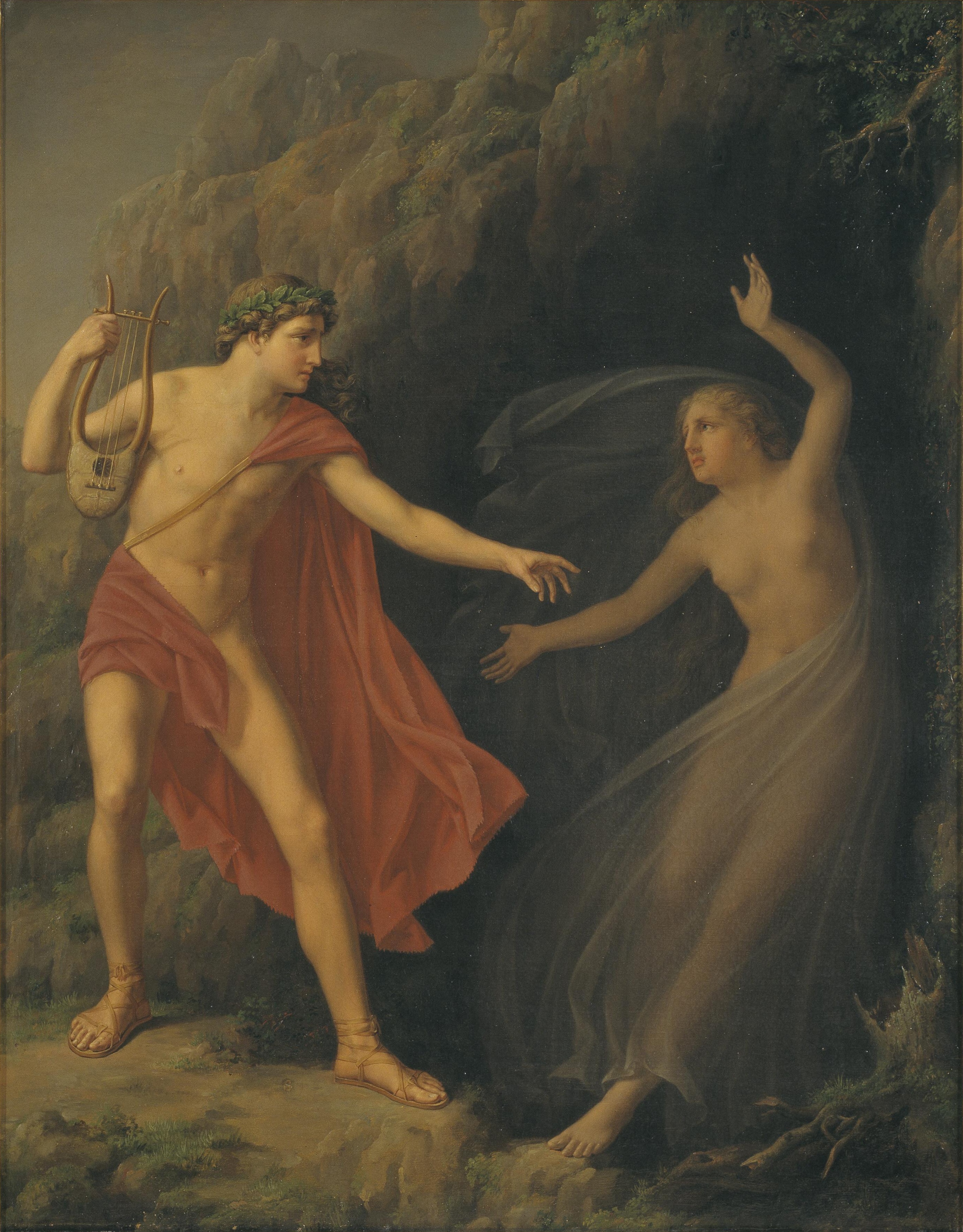
Carl Goos - Orpheus and Eurydice - KMS276 - Statens Museum for Kunst
As soon as he saw some light Orpheus realized he had come out of the Underworld and turned. Unfortunately
Eurydice accused a pain in the ankle bitten by the snake and, therefore, delayed. So Orpheus transgressed
the condition placed by Hades. Only then did Eurydice understand and, to his beloved, whisper dramatic words
and poignant: "Thanks, my love, you have done all you can to save me".
They then took each other by the hand, aware that this was the last time. Hermes, with sad face and
compassionate expression, he held Eurydice by the hand, because that was what he had promised to Hades.
Orpheus saw Eurydice disappear and despaired, because he knew he would never see her again. He decided
then not to desire any other woman.

John William Waterhouse: Nymphs Finding
the Head of Orpheus
John William Waterhouse: 06/04/1849 - 10/02/1917. Pittore inglese appartenente alla corrente preraffaellita, la sua pittura subisce da una parte l'influenza stilistica di quella corrente ma dall'altra anche quella degli impressionisti suoi contemporanei. I suoi dipinti sono prevalentemente a soggetto mitologico o arturiano.
Long afterwards a group of drunken Bacchantes invited Orpheus to participate in a Dionysian orgy. For live up to his promise, he renounced, and this is exactly what led him to death: the Bacchantes, enraged, they tore him to pieces and threw his head into the river Evros, along with his lyre. The head fell right on the lyre and floating, he continued to sing sweetly. Zeus, touched by this event moving, took the lyre and placed it in the sky forming a constellation.

La costellazione della Lyra nella rappresentazione classica di
Johannes Hevelius
Johannes Hevelius: 28/01/1611 - 28/01/1687. Astronomo polacco, conosciuto sotto il nome latinizzato di Johannes Hevelius mentre il realta' il suo nome originario era Jan Heweliusz. Fondatore della topografia lunare, fu non solo un abile e scrupoloso osservatore del cielo ma anche un valente artista; scopri' quattro comete e teorizzo' che queste potessero percorrere orbite paraboliche. Una delle sue opere fondamentali furono le carte celesti della Uranographia, esempio di arte raffinata congiunta a rigore scientifico.
Nelle carte celesti moderne la costellazione della Lyra viene ormai rappresentata in forma schematizzata, cosi'
come tutte le altre costellazioni; nei secoli passati pero' si preferiva l'interpretazione classica, con disegni
elaborati e spesso di grande valore artistico. Sono un esempio le carte celesti redatte da Johannes Hevelius,
pubblicate postume a Danzica dalla seconda moglie dell'astronomo, Elzbieta Koopman, che sostenne sempre
il marito e che viene considerata come la prima astronoma della storia.
Considerate universalmente come dei capolavori dell’arte incisoria del XVII secolo; le carte celesti di Hevelius
comprendono 56 tavole a doppia pagina, ricavate da incisioni su rame, raffiguranti le costellazioni cosi' come le
descrive la mitologia classica. Sono raccolte nella Firmamentum Sobiescianum, sive Uranographia che
e' in realta' uno dei tre volumi dell'opera complessiva Prodromus Astronomiae; il titolo del volume che
contiene le carte del cielo si puo' tradurre come "Il cielo dei Sobieski" e fa riferimento a Jan III
Sobieski, re della Confederazione Polacco-Lituana dal 1674 al 1696, al quale il libro venne dedicato.
Andromeda and Perseus
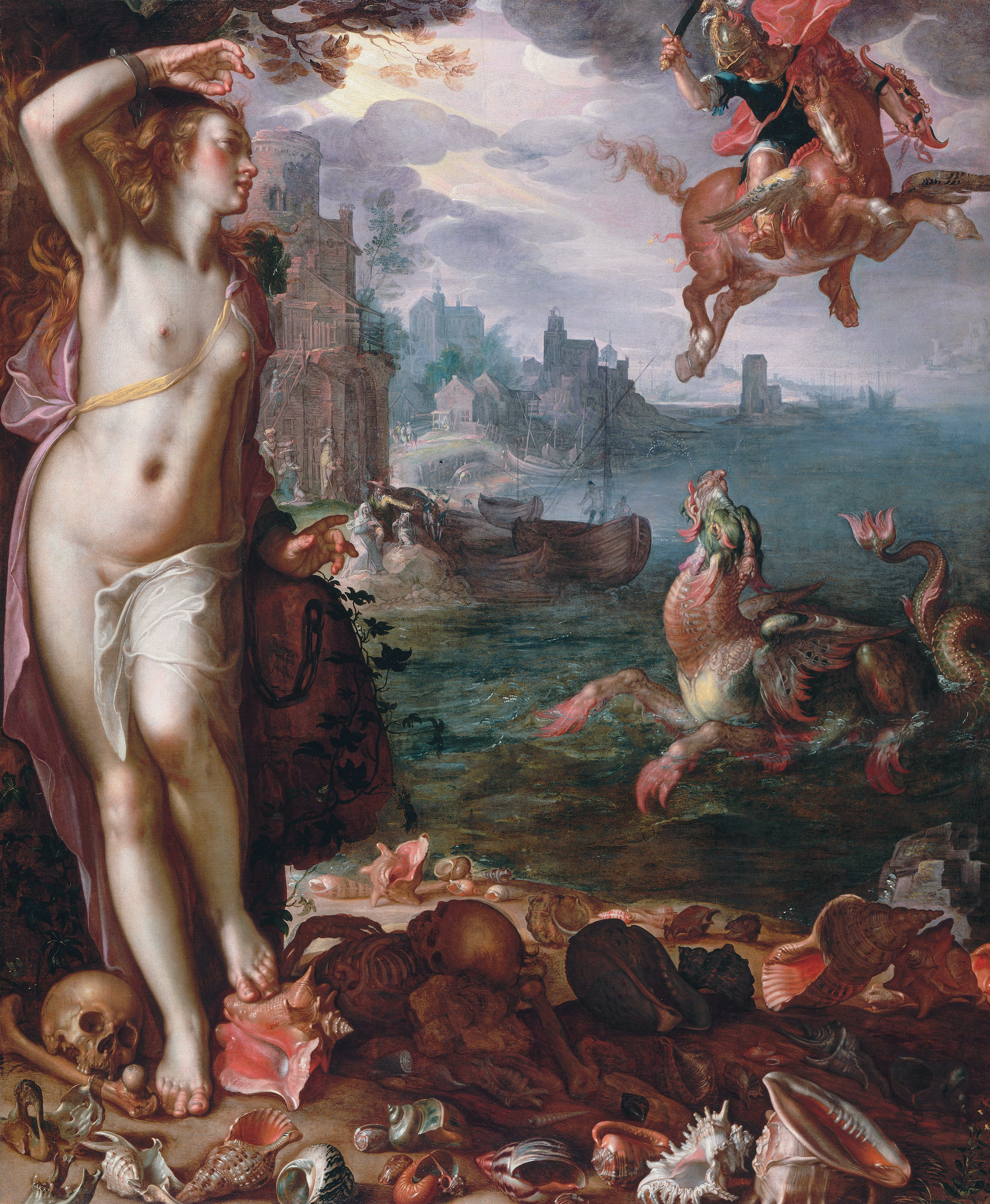
Perseo combatte contro il mostro marino per liberare Andromeda; dipinto olio su tela (180x150) di
Joachim Wtewael: Parigi, Musee du
Louvre.
Immagine da Iconos, Cattedra di Iconografia e Iconologia, Dipartimento di Storia dell'arte e spettacolo,
Facolta' di Lettere e Filosofia, Sapienza Universita' di Roma; sezione Le Metamorfosi di Ovidio.
Joachim Wtewael: 1566 - 1638. Pittore ed incisore olandese, Visito' la Francia e l'Italia nel corso di circa quattro anni e nel 1592 fu maestro nella gilda
Zadelaar di Utrecht (1611)
The beautiful princess Andromeda, daughter of the King of Ethiopia Cepheus and Cassiopeia, had been offered
in sacrifice to Poseidon, the God of the Sea, to wash away the shame of the insult that the Queen had
addressed to the Nymphs of the sea. The princess was chained to the cliff and was about to be devoured by
the horrible marine monster (Cetus) sent by Poseidon.
Suddenly Perseus appeared in the sky, riding the winged horse Pegasus, returning from the victory with the
Medusa, whose gaze petrified every living being; he engaged in an epic fight with Cetus in defense by
Andromeda. Perseus had kept in a sack the severed head of the Medusa and showed it to Cetus, forever
petrifying the sea monster.
He then freed Andromeda who fell head over heels in love with his savior and the two married soon after the
right wedding.
All the characters of this adventure were then turned into constellations by the gods, thus giving them
immortality. Andromeda and Perseus, Cassiopeia and Cepheus, the winged horse Pegasus and the monster Cetus.
Here are the classic representations of these constellations as interpreted by the artistic genius of the
astronomer
Johannes Hevelius (1611-1687).
All images from
Wikipedia Commons

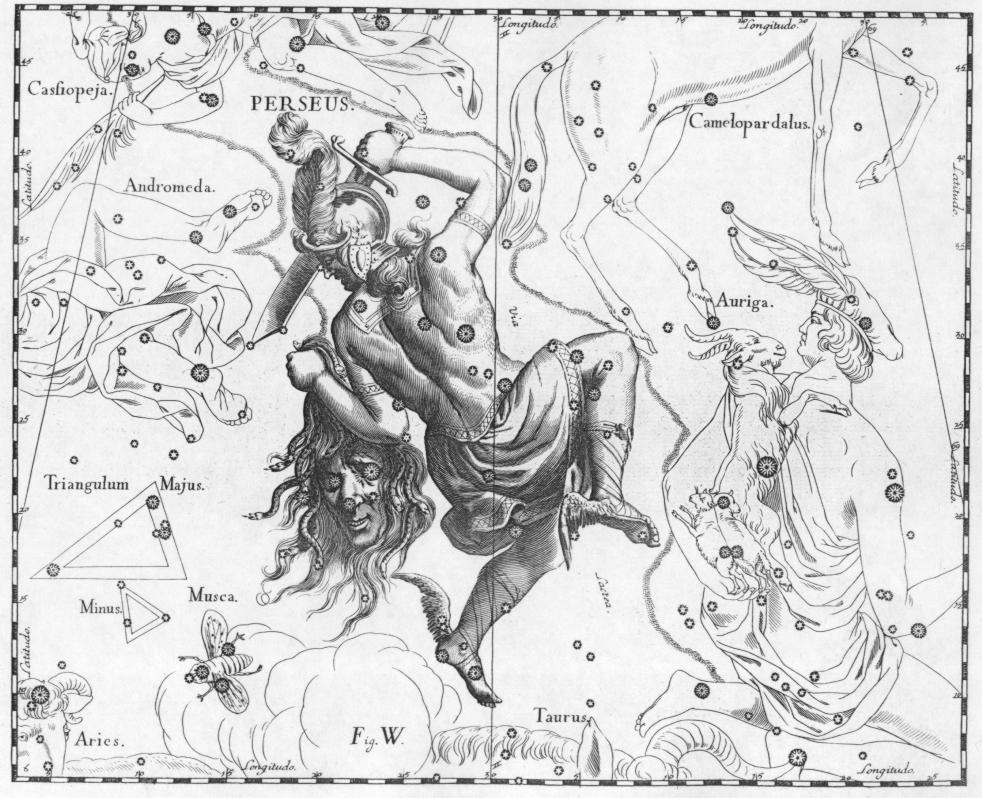



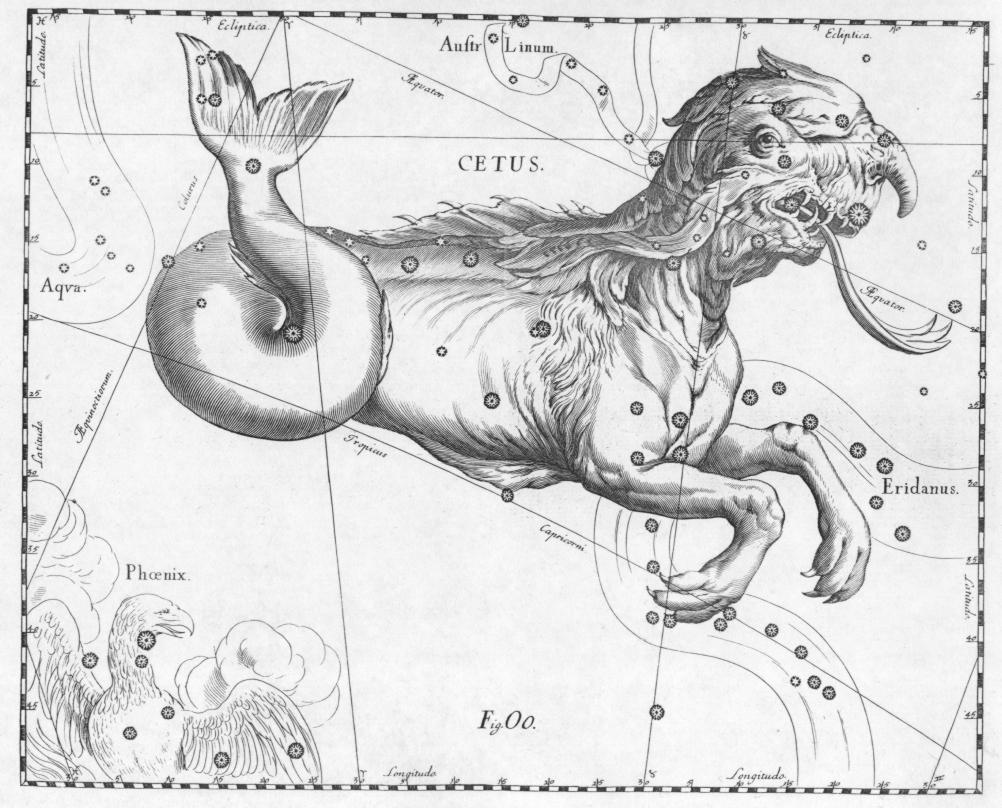

On the left Perseus and Andromeda, wall painting from Pompeii, 1st century. Museo Archeologico Nazionale di Napoli

Perseus save Andromeda, Giorgio Vasari
oil on wood 117x100 cm, Florence, Palazzo Vecchio, Studiolo di Francesco I
Callisto
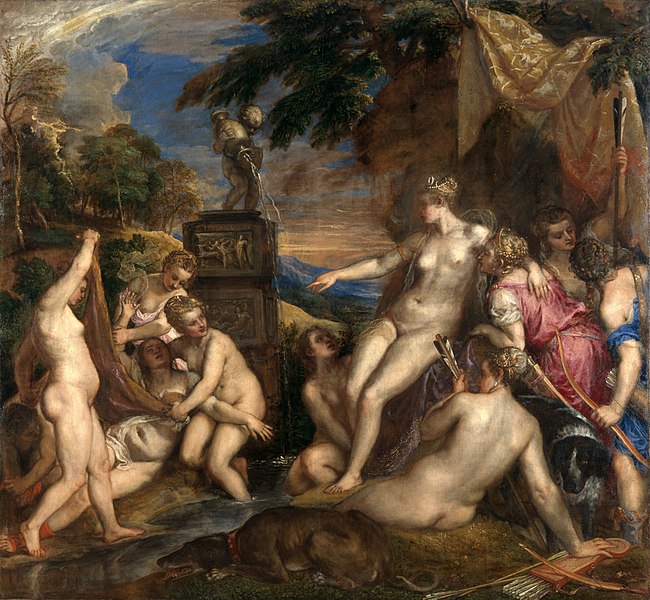
Artemis (Diana) discovers Callisto's pregnancy, Tiziano: The National Gallery, London and The National Gallery of Scotland, Edinburgh
Tiziano Vecellio (1488 - 1576), known simply as Tiziano, was an Italian painter who was a citizen of the Republic of Venice and an important exponent of the Venetian school.
Callisto was a nymph of extraordinary beauty who always accompanied Artemis (Diana for the Latins), the
Goddess of the Hunt. Zeus fell in love with her and, disguised as Artemis, managed to surround the young
nymph. From the union a son was born, Arcade. Artemis chased Callisto and Hera (Juno), Zeus' wife, took
revenge by turning Callisto into a bear.
When Arcade, as an adult, was about to unknowingly kill his mother, Zeus intervened to save them both from
the wrath of Hera transformed them into constellations, such as Ursa Major and Ursa Minor; the two
constellations are also known by the names of Big Dipper and Little Dipper, from the typical shape given
by the arrangement of the main stars.


Ursa Major and Ursa Minor constellation drawing by Johannes Hevelius (1611-1687)

Many other artists have depicted this legend, such as Cesar van Everdingen: Jupiter and Callisto of 1655 (Nationalmuseum, Stockholm)
Cesar van Everdingen (1606 - 1678); Dutch painter, mainly portraitist but also painted historical scenes or scenes that recall classical myths.
Ophiucus
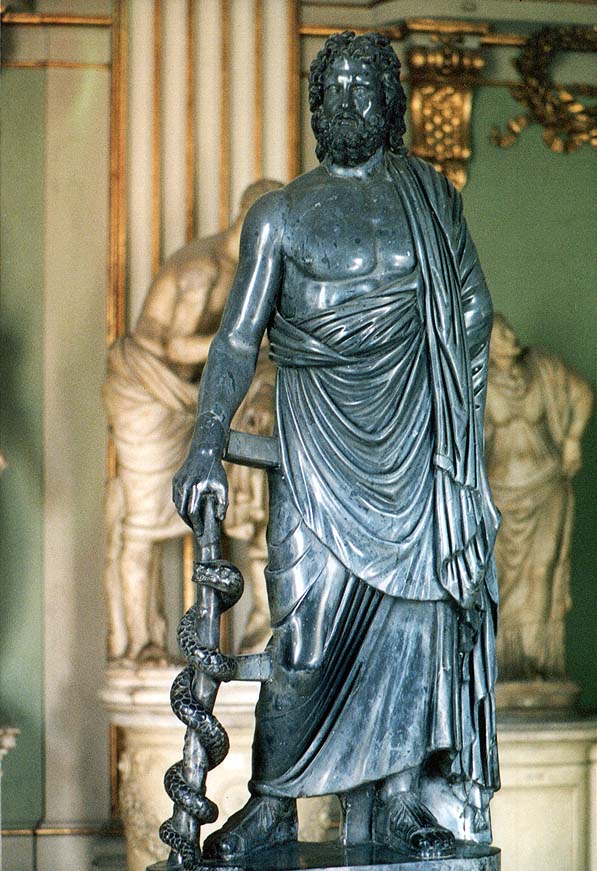
Statue of Aesculapius, Musei Capitolini, Rome
Asclepius (Aesculapius for the Latins) was the son of Apollo and Coronis. Legend has it that Coronis
betrayed Apollo with a mortal, Ischys, while she was pregnant with Asclepius. A crow, a bird that until then
was been candid, brought the bad news to the god but instead of the reward he expected he was cursed by
Apollo who made him black.
In a fit of jealousy, Apollo struck Coronis with an arrow. But then he repented of his gesture and rather
than seeing her baby die with her, the god tore the fetus from her mother's womb before the flames of the
funeral pyre enveloped her; he entrusted the newborn to Chiron, the wise centaur (represented in the sky
by the constellation of the Centaur).
Chiron raised Asclepius like a son and taught him the arts of healing and hunting. Asclepius became so
skilled in medicine that he not only managed to save lives, but also resurrected from dead.
In Crete he brought Glaucus back to life, the young son of King Minos: Asclepius was examining the body of
Glaucus was killed after a serious accident when a snake approached. He promptly killed him with his stick;
then another snake came forward with a grass in its mouth which it placed on the body of the dead one who
magically returned to life. Asclepius took the same herb and placed it on Glaucus' body, and the magical
effect was repeated; from that moment Asclepius began to use this herb and it quickly became the most famous
of all doctors.

The Ophiuchus constellation in the artistic interpretation of Johannes Hevelius
Hades, god of the underworld, soon realized that the flow of dead souls into his kingdom would have been
drastically reduced if this technique had become common knowledge. Protested to Zeus, the god his brother,
and that struck Asclepius with the thunderbolt. Apollo felt outraged by the severe treatment reserved for
his son and he took his revenge by killing the three Cyclops who forged the thunderbolts of Zeus.
To appease Apollo, Zeus made Asclepius immortal and placed him among the stars as a constellation of
Ophiuchus.
In all the representations of the constellation, Ophiuchus holds in his hands a snake, which has become a
symbol of medicine.
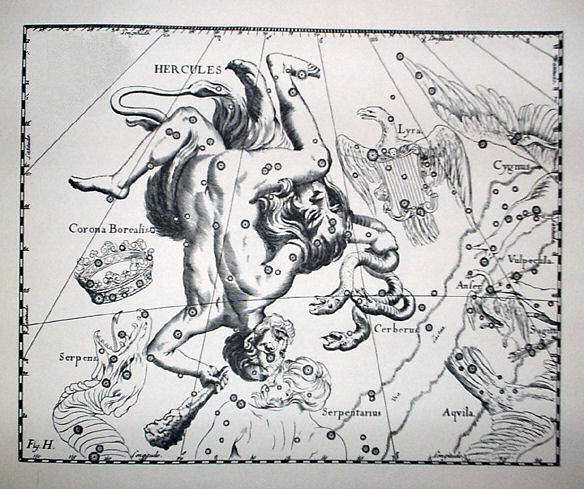
The Hercules constellation, represented according to the classical vision by Johannes Hevelius.
Europa

Kidnapping of Europa by Rembrandt: 1632. This painting is considered one of the greatest examples of Baroque painting.
Rembrandt (15/07/1606 - 04/10/1669): Dutch painter and engraver, he is considered one of the greatest painters in the history of European art and the most important of the Dutch one. His period of activity coincides with what historians call the Dutch Golden Age.
Europe was a young and beautiful princess, daughter of King Agenor and of Telefassa, who lived in
Phenicia. One day Zeus, from the heights of heaven, met the beautiful princess together with her maids on the
bank of the sea, where Europe loved to bathe and pick flowers. Zeus immediately fell in love with her and not to
intimidate her maidens took the form of a white bull and grazed the grass of the meadow.
The girls, seeing him calm, began to caress him, even Europe climbed on his back. Then the bull jumped and
began a long run: Europe was so scared that she no longer had a voice to shout and clung tight to the bull
that after hours and hours of walking arrived on the island of Crete, where he finally turned into Zeus and
declared his love for Europe.

From the union of the father of the gods with the girl three children were born including Minos, the future king of the island of Crete. To remember this event, Taurus was placed in the sky as a constellation.
Leda e il Cigno

Leda with the Cygnus, Galleria degli Uffizi, Firenze.
Painting attributed to Francesco Melzi
Francesco Melzi (1491 - 1570): Italian painter was a rather mysterious character, coming from a rich patrician family; bound by deep friendship with Leonardo da Vinci, he inherited all his manuscripts that he kept and cataloged with care until his death.
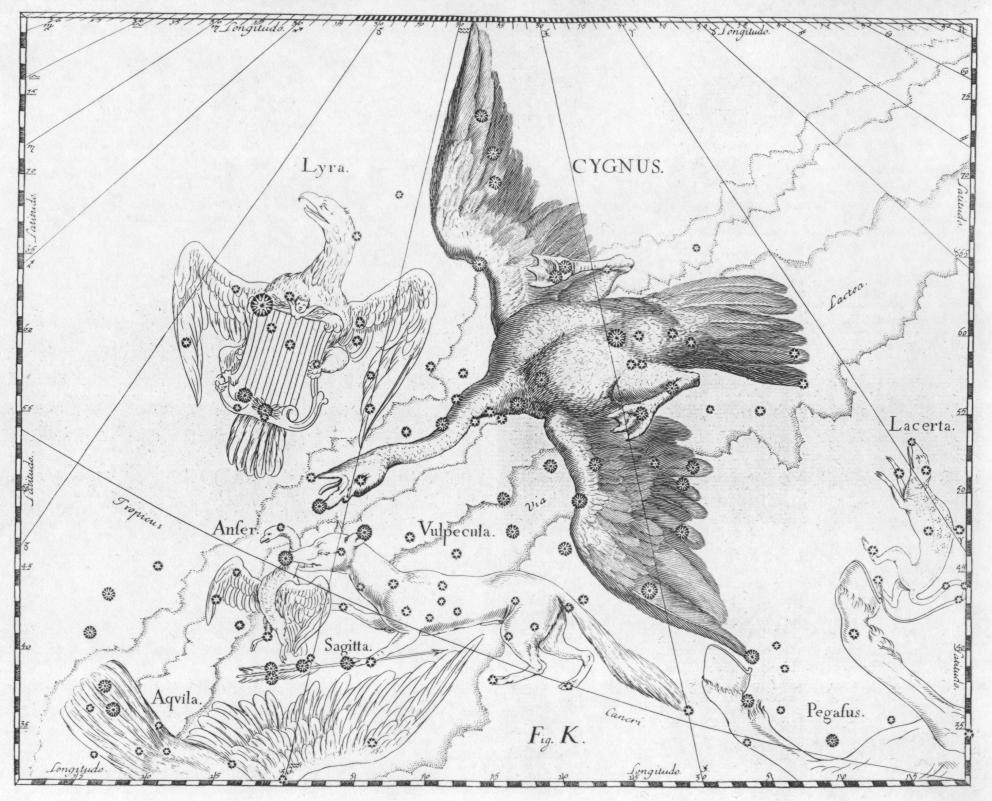
Castore e Polluce

Castor and Pollux are the "Dioscuri", first century after Christ unknown author, Museo del Prado, Madrid



